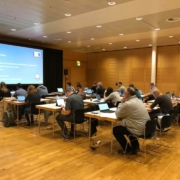Jira & Confluence Together: The Issue Collector
The issue collector allows you to embed a trigger tab into any website. When clicked, this prompts the user to fill in a form which creates an issue in Jira. You may be wondering why this is useful.
1: Users do not have access to Jira
It could be the case that you have users with access to Confluence but not to Jira. In this case, and if you were using Confluence Server, an example could be for managing internal processes, specifically managing expense claims. In this example, the trigger tab is embedded in the Finance space in Confluence. People with access to Confluence create the expense claim and the Finance team would like you to create an issue to that they can manage your expense claim. This is the example we have discussed in the Issue Collector for Server post.
2: Users do not have access to the Finance project
This use case is the same as the first example, but users do have access to Jira. They do not, however, have access to the Finance project. That project has to be completely unavailable to people who are not members of the finance team.
3: Collecting user feedback and bug reports from an external web site
You could also embed this into functionality into any website and use it to gather feedback or bug reports. In this example, the issue collector allows you to manage that feedback internally.
Let’s look at how to use the Issue Collector. We’ve created two tutorials so you can try out this feature for yourself.
In this tutorial, we are creating an Issue Collector for Jira Cloud. In Cloud, of course, the ability to edit layouts is locked down, so you can’t embed an Issue Collector into a Confluence space. This does not however stop you from harnessing the power of Jira. You can still embed the Issue Collector into your websites. In example, use this form to gather feedback on products or apps that your company creates and manages in Jira.
Jira Permissions needed to create an issue collector:
You must have the Administer Jira global permission. This means that you must belong to a group that is associated with that global permission.
You also need the Administer Projects project permission.
Step 1:
- First locate a Jira project where you want to add the Issue Collector.
- From the project administration page, click the Issue Collectors tab.
- Then click the Add Issue Collector on the page.

Step 2:
- Specify the relevant details to the Add Issue Collector screen.
- I’m going to use this to gather bug reports on the latest app that my company has released. (I’ve selected the Bug issue type) You can configure the collector for any issue type as well as gather any sort of feedback.

Step 3:
- You can add more fields if you like, but since this is an example I’ve decided to keep it simple. Check the feedback template and click Submit.

Step 4:
- Now you can see the embed code for either HTML or Javascript.
- In this example, we are going to embed the code in a sample web page so that we can test if it’s functioning correctly.

Step 5:
- You now need to embed this code into your website, so you’ll either need to speak to the people who manage your website or DIY in order to do so.
- As Jira instructs you, just copy that code and make sure you add it into the correct part of the page.
- Copy the HTML code from Jira.

- Paste the code just before the finishing tag of your HTML
Once you have pasted the code, save it, and go ahead and test!
- Fill in your form with content and then submit.

And you’re done!
If you’d like to learn more about the integration between Jira and Confluence, why not take the Jira and Confluence together course? See our Jira and Confluence Atlassian Training course options for more details.




